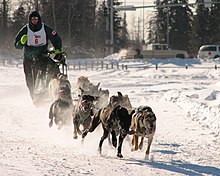Anthrozoology
From Wikipedia, the free encyclopedia
| Part of a series on |
| Ethology |
|---|
 |
| Part of a series on |
| Zoology |
|---|
 |
Anthrozoology (also called human–animal studies, or HAS) is the study of interaction between living things. It is a modern interdisciplinary and burgeoning field that overlaps with a number of other disciplines, including anthropology, ethology, medicine, psychology, veterinary medicine and zoology. A major focus of anthrozoologic research is the quantifying of the positive effects of human-animal relationships on either party and the study of their interactions.[1] It includes scholars from a diverse range of fields, including anthropology, sociology, biology, history and philosophy.[2]
Anthrozoology scholars recognize the lack of scholarly attention given to non-human animals and to the relationships between human and non-human, especially in the light of the magnitude of animal representations, symbols, stories and their actual physical presence in human societies and cultures. Rather than a unified approach, the field currently consists of several methods adapted from the several participating disciplines to encompass human-nonhuman relationships and occasional efforts to develop sui generis methods.
Areas of study[edit source]
| This section is in a list format that may be better presented using prose. (August 2013) |
- The interaction and enhancement within captive animal interactions.
- Affective (emotional) or relational bonds between humans and animals
- Human perceptions and beliefs in respect of other animals.
- How some animals fit into human societies.
- How these vary between cultures, and change over times.
- The study of animal domestication: how and why domestic animals evolved from wild species (paleoanthrozoology).
- Captive zoo animal bonds with keepers
- The social construction of animals and what it means to be animal
- The zoological gaze
- The human-animal bond
- Parallels between human-animal interactions and human-technology interactions
- The symbolism of animals in literature and art
- The history of animal domestication
- The intersections of speciesism, racism, and sexism
- The place of animals in human-occupied spaces
- The religious significance of animals throughout human history
- Exploring the cross-cultural ethical treatment of animals
- The critical evaluation of animal abuse and exploitation
- Mind, Self, and Personhood in nonhuman animals
Growth of the field[edit source]
There are now twenty-three college programs in HAS or a related field in the United States, Canada, Great Britain, Germany, Israel and the Netherlands, as well as an additional eight veterinary school programs in North America, and over thirty HAS organizations in the US, Canada, Great Britain, Australia, France, Germany, New Zealand, Israel, Sweden, and Switzerland.
In the UK, the University of Exeter runs an MA in Anthrozoology which explores human-animal interactions from anthropological (cross-cultural) perspectives.
There are now three primary lists for HAS scholars and students: H-Animal, the Human-Animal Studies listserve, and NILAS, as well as the Critical Animal Studies list.
There are now over a dozen journals covering HAS issues, many of them founded in the last decade, and hundreds of HAS books, most of them published in the last decade. Brill, Berg, Johns Hopkins, Purdue, Columbia, Reaktion, Palgrave-McMillan, University of Minnesota, University of Illinois, and Oxford all offer either a HAS series or a large number of HAS books.
In addition, in 2006, Animals and Society Institute began hosting the Human-Animal Studies Fellowship, a six-week program in which pre- and post-doctoral scholars work on a HAS research project at a university under the guidance of host scholars and distance peer scholars. Beginning in 2011, ASI has partnered with Wesleyan Animal Studies, who will be hosting the fellowship in conjunction with ASI. There are also a handful of HAS conferences per year, including those organized by ISAZ and NILAS, and the Minding Animals conference, held in 2009 in Australia. Finally, there are more HAS courses being taught now than ever before. The ASI Website's course pages list over 300 courses (primarily in North America, but also including Great Britain, New Zealand, Australia, Germany, and Poland) in twenty-nine disciplines at over 200 colleges and universities, not including over 100 law school courses.
See also[edit source]
References[edit source]
- ^ Mills, Daniel S. "Anthrozoology", The Encyclopedia of Applied Animal Behaviour and Welfare. CABI 2010, pp. 28–30.
- ^ DeMello, Margo. Teaching the Animal: Human–Animal Studies Across the Disciplines. Lantern Books, 2010, p. xi. and Hurn, Samantha. Humans and Other Animals. Pluto Press, 2012.
- Also see Animals & Society Institute, accessed February 23, 2011.
- Note: the term should not be confused with "animal studies," which often refers to animal testing.
External links[edit source]
| ||
| |||







No hay comentarios:
Publicar un comentario